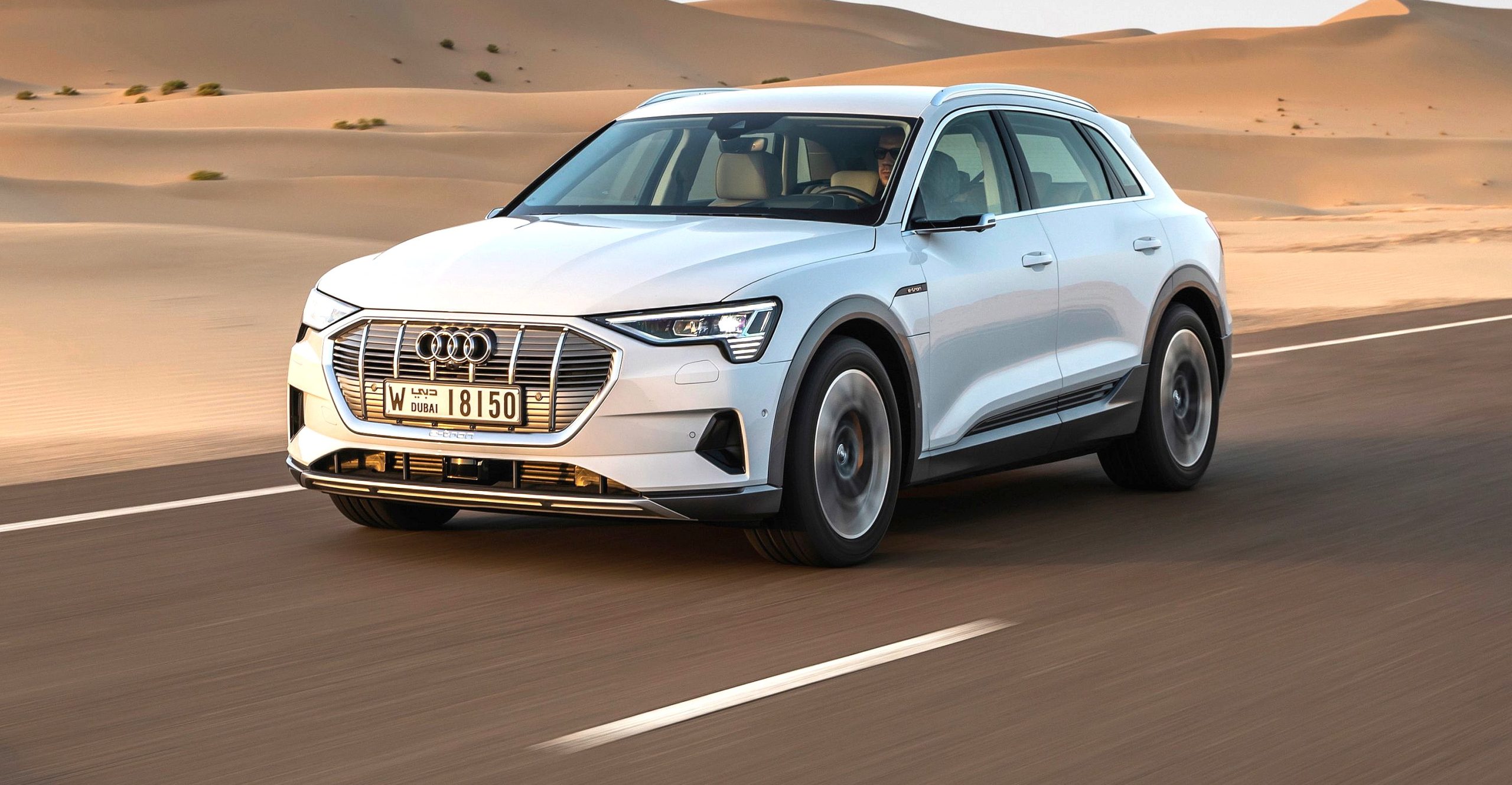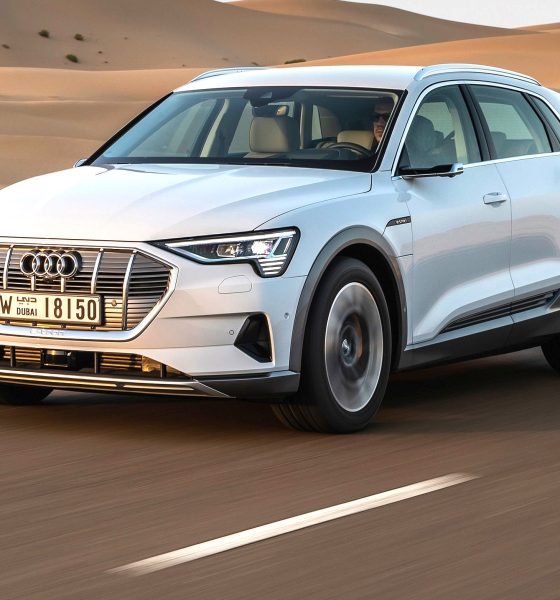

News
Audi e-tron navigation system provides detailed petrol information to drivers (UPDATE)
It appears that while the Audi e-tron is a solid-built all-electric SUV with a premium price to match, the German automaker might have neglected to adjust some of the vehicle’s finer details. Take the e-tron’s navigation system, for example, which was recently observed to have a very interesting, and notably humorous feature: it gives drivers useful information about nearby petrol stations and current gas prices.
The e-tron, similar to other electric vehicles such as Tesla’s electric cars, uses its navigation to help drivers find rest stops and charging spots during trips. This is incredibly important for electric vehicles, particularly SUVs like the e-tron that only have a rather limited 204 miles of range per charge as per the vehicle’s EPA rating. Tesla’s electric cars perform this feature flawlessly, with vehicles laying out a route for drivers that clearly indicates where charging services are available.
As noted by drivers who shared images of the e-tron’s navigation in action, the all-electric SUV’s infotainment screen displays information about petrol stations on a selected route. The information is quite detailed too, as it includes the current price of petrol in selected locations. Images shared by Robin Engelhardt, for one, showed that the SUV had information about diesel prices in the area.
While humorous, the bug in the e-tron’s current navigation is likely due to the fact that the all-electric SUV’s infotainment system is taken from other vehicles in the company’s lineup. The e-tron melds well with Audi’s other vehicles in the way that its design theme is very similar to the company’s internal combustion cars. As such, components like the e-tron’s infotainment system are likely used for gas-powered vehicles as well.
The gas stations and diesel price information on the e-tron’s navigation system are likely the result of an honest oversight from Audi, and it is one that could be addressed through a software update. Nevertheless, the quirk does highlight a notable lack of attention to detail on the carmaker’s part. Audi is a premium brand, and the e-tron is not a vehicle that is designed for the mass market. At prices that are closer to the Tesla Model X than the Model 3, consumers purchasing the e-tron would likely expect a car that was meticulously tuned as an electric vehicle. Having a navigation system that is optimized for petrol stations does not help much in this sense.
This is especially notable considering that the e-tron continues to receive glowing reviews from organizations such as Consumer Reports, whose reviewers actually listed the vehicle’s infotainment system as a strong point of the all-electric SUV. Consumer Reports has warmly received the e-tron, even describing the vehicle’s deliberate acceleration as a more of an “elegant pull away.” That said, the e-tron remains a pretty solid vehicle, as revealed by its stellar safety ratings from the IIHS, which recently gave the SUV a Top Safety Pick+ rating.
Update: An Audi spokesperson has reached out to us with regards to the e-tron’s Navigation quirk. Following is the carmaker’s statement:
“The Audi MMI navigation system is designed to aid in everyday situations, including finding stops along the way of any given journey. Oftentimes, that means stopping at gas stations where drivers and passengers can stop for breaks or food. While the Audi e-tron is fully electric, these conveniences go a long way toward helping our customers, and displaying gas prices can be turned off in the MMI’s sub-menus. Additionally, the Audi e-tron comes with an up-to-date roster of available charging stations throughout the U.S. and elsewhere in its navigation to support long-distance driving.“

Elon Musk
Elon Musk’s X will start using a Tesla-like software update strategy
The initiative seems designed to accelerate updates to the social media platform, while maintaining maximum transparency.

Elon Musk’s social media platform X will adopt a Tesla-esque approach to software updates for its algorithm.
The initiative seems designed to accelerate updates to the social media platform, while maintaining maximum transparency.
X’s updates to its updates
As per Musk in a post on X, the social media company will be making a new algorithm to determine what organic and advertising posts are recommended to users. These updates would then be repeated every four weeks.
“We will make the new 𝕏 algorithm, including all code used to determine what organic and advertising posts are recommended to users, open source in 7 days. This will be repeated every 4 weeks, with comprehensive developer notes, to help you understand what changed,” Musk wrote in his post.
The initiative somewhat mirrors Tesla’s over-the-air update model, where vehicle software is regularly refined and pushed to users with detailed release notes. This should allow users to better understand the details of X’s every update and foster a healthy feedback loop for the social media platform.
xAI and X
X, formerly Twitter, has been acquired by Elon Musk’s artificial intelligence startup, xAI last year. Since then, xAI has seen a rapid rise in valuation. Following the company’s the company’s upsized $20 billion Series E funding round, estimates now suggest that xAI is worth tens about $230 to $235 billion. That’s several times larger than Tesla when Elon Musk received his controversial 2018 CEO Performance Award.
As per xAI, the Series E funding round attracted a diverse group of investors, including Valor Equity Partners, Stepstone Group, Fidelity Management & Research Company, Qatar Investment Authority, MGX, and Baron Capital Group, among others. Strategic partners NVIDIA and Cisco Investments also continued support for building the world’s largest GPU clusters.
News
Tesla FSD Supervised wins MotorTrend’s Best Driver Assistance Award
The decision marks a notable reversal for the publication from prior years, with judges citing major real-world improvements that pushed Tesla’s latest FSD software ahead of every competing ADAS system.

Tesla’s Full Self-Driving (Supervised) system has been named the best driver-assistance technology on the market, earning top honors at the 2026 MotorTrend Best Tech Awards.
The decision marks a notable reversal for the publication from prior years, with judges citing major real-world improvements that pushed Tesla’s latest FSD software ahead of every competing ADAS system. And it wasn’t even close.
MotorTrend reverses course
MotorTrend awarded Tesla FSD (Supervised) its 2026 Best Tech Driver Assistance title after extensive testing of the latest v14 software. The publication acknowledged that it had previously criticized earlier versions of FSD for erratic behavior and near-miss incidents, ultimately favoring rivals such as GM’s Super Cruise in earlier evaluations.
According to MotorTrend, the newest iteration of FSD resolved many of those shortcomings. Testers said v14 showed far smoother behavior in complex urban scenarios, including unprotected left turns, traffic circles, emergency vehicles, and dense city streets. While the system still requires constant driver supervision, judges concluded that no other advanced driver-assistance system currently matches its breadth of capability.
Unlike rival systems that rely on combinations of cameras, radar, lidar, and mapped highways, Tesla’s FSD operates using a camera-only approach and is capable of driving on city streets, rural roads, and freeways. MotorTrend stated that pure utility, the ability to handle nearly all road types, ultimately separated FSD from competitors like Ford BlueCruise, GM Super Cruise, and BMW’s Highway Assistant.
High cost and high capability
MotorTrend also addressed FSD’s pricing, which remains significantly higher than rival systems. Tesla currently charges $8,000 for a one-time purchase or $99 per month for a subscription, compared with far lower upfront and subscription costs from other automakers. The publication noted that the premium is justified given FSD’s unmatched scope and continuous software evolution.
Safety remained a central focus of the evaluation. While testers reported collision-free operation over thousands of miles, they noted ongoing concerns around FSD’s configurable driving modes, including options that allow aggressive driving and speeds beyond posted limits. MotorTrend emphasized that, like all Level 2 systems, FSD still depends on a fully attentive human driver at all times.
Despite those caveats, the publication concluded that Tesla’s rapid software progress fundamentally reshaped the competitive landscape. For drivers seeking the most capable hands-on driver-assistance system available today, MotorTrend concluded Tesla FSD (Supervised) now stands alone at the top.
News
Elon Musk’s Grokipedia surges to 5.6M articles, almost 79% of English Wikipedia
The explosive growth marks a major milestone for the AI-powered online encyclopedia, which was launched by Elon Musk’s xAI just months ago.

Elon Musk’s Grokipedia has grown to an impressive 5,615,201 articles as of today, closing in on 79% of the English Wikipedia’s current total of 7,119,376 articles.
The explosive growth marks a major milestone for the AI-powered online encyclopedia, which was launched by Elon Musk’s xAI just months ago. Needless to say, it would only be a matter of time before Grokipedia exceeds English Wikipedia in sheer volume.
Grokipedia’s rapid growth
xAI’s vision for Grokipedia emphasizes neutrality, while Grok’s reasoning capabilities allow for fast drafting and fact-checking. When Elon Musk announced the initiative in late September 2025, he noted that Grokipedia would be an improvement to Wikipedia because it would be designed to avoid bias.
At the time, Musk noted that Grokipedia “is a necessary step towards the xAI goal of understanding the Universe.”
Grokipedia was launched in late October, and while xAI was careful to list it only as Version 0.1 at the time, the online encyclopedia immediately earned praise. Wikipedia co-founder Larry Sanger highlighted the project’s innovative approach, noting how it leverages AI to fill knowledge gaps and enable rapid updates. Netizens also observed how Grokipedia tends to present articles in a more objective manner compared to Wikipedia, which is edited by humans.
Elon Musk’s ambitious plans
With 5,615,201 total articles, Grokipedia has now grown to almost 79% of English Wikipedia’s article base. This is incredibly quick, though Grokipedia remains text-only for now. xAI, for its part, has now updated the online encyclopedia’s iteration to v0.2.
Elon Musk has shared bold ideas for Grokipedia, including sending a record of the entire knowledge base to space as part of xAI’s mission to preserve and expand human understanding. At some point, Musk stated that Grokipedia will be renamed to Encyclopedia Galactica, and it will be sent to the cosmos.
“When Grokipedia is good enough (long way to go), we will change the name to Encyclopedia Galactica. It will be an open source distillation of all knowledge, including audio, images and video. Join xAI to help build the sci-fi version of the Library of Alexandria!” Musk wrote, adding in a later post that “Copies will be etched in stone and sent to the Moon, Mars and beyond. This time, it will not be lost.”








